A disponibilidade de água quente é um dos atributos indispensáveis para uma vida confortável. Os habitantes das cidades estão de tal forma habituados a estas condições que o corte temporário do abastecimento de água quente traz muitos inconvenientes. Também há falta de água quente no campo, nas dachas. Resolver este problema pode aquecedor de água de fluxo elétrico. Este dispositivo pode fornecer água quente não só temporariamente, mas também de forma permanente: pode construir um sistema de abastecimento de água quente para uma casa privada.
Conteúdo do artigo
Princípio, dispositivo e caraterísticas de funcionamento
Aquecedor elétrico de água de fluxo - um dispositivo de pequenas dimensões que aquece a água que passa através dele. O elemento de aquecimento é um TEN (aquecedor elétrico tubular) ou uma espiral aberta. Os aquecedores com TENS são mais comuns - são mais seguros e o elemento de aquecimento é mais fácil de substituir. Nos modelos muito compactos - bicos de torneira, etc.. - simplesmente não há lugar para colocar o elemento de aquecimento, pelo que se utiliza uma bobina aberta.
O aparelho liga-se quando o caudal aparece (a torneira é aberta) e desliga-se quando o caudal desaparece. A temperatura definida é marcada em alguns segundos e depois mantida constantemente (com potência suficiente do elemento de aquecimento).
Externamente, o esquentador elétrico de fluxo normal é uma pequena caixa de plástico, ligada à água fria e à eletricidade. Tem uma saída para água quente. Dependendo da sua finalidade, pode fornecer água quente a uma (individual) ou a várias (sistema) saídas.
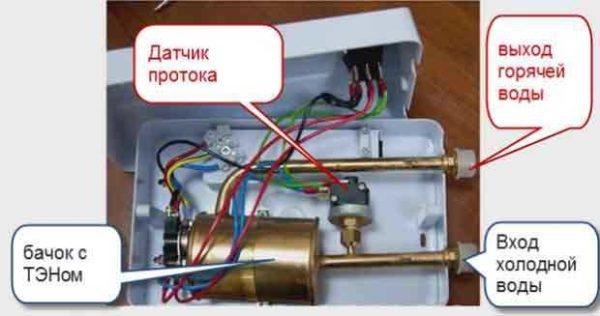
A estrutura do aquecedor de água de fluxo não é complicada, existem os seguintes elementos:
- Entrada de água fria. Liga-se ao abastecimento de água, normalmente com uma mangueira flexível entrançada.
- Sensor de caudal. Detecta o aparecimento de água no aparelho (a torneira é aberta) e liga a resistência. Também desliga o aquecimento quando o fluxo desaparece (torneira fechada).
- Tanque com um elemento de aquecimento. Um pequeno recipiente, no interior do qual se encontra um elemento de aquecimento, curvado em forma de espiral. É aqui que a água é aquecida.
- Saída de água quente. Do depósito com água sai um tubo, através do qual a água aquecida é descarregada.
Como se pode ver, o dispositivo é simples. Existe também um painel de controlo na tampa, onde são retirados os condutores do sensor de fluxo e da RTE - para que possa ajustar o modo de funcionamento e monitorizar o estado do dispositivo (indicação de inclusão).
Tipos e ligação ao abastecimento de água e eletricidade
Existem dois tipos principais de esquentadores eléctricos de fluxo: pressurizados e não pressurizados. Os pressurizados são também chamados de sistema e têm frequentemente a palavra Sistem no seu nome. Estão ligados ao tubo de água, têm normalmente uma grande capacidade e podem fornecer água quente a dois ou mais pontos de água.
Os aquecedores de água sem pressão ou de fluxo individual são ligados como aparelhos domésticos normais - através de uma mangueira flexível ou de uma saída de um tubo de água. Fornecem água aquecida a um ponto, têm uma capacidade relativamente pequena (3-7 kW) e um custo reduzido. Existem numa variedade de formas:
Se precisar de aguardar algumas semanas de interrupção do fornecimento de água quente, pode colocar um termoacumulador elétrico de fluxo individual não pressurizado de qualquer tipo. Se precisar de um fornecimento constante de água quente, é mais racional instalar uma unidade de pressão.
Ligação de um aquecedor de água sob pressão ao sistema de abastecimento de água
Os aquecedores de água eléctricos de pressão ou de sistema são ligados ao sistema de abastecimento de água existente através de uma rutura de tubo. São ligados através de um tê que é instalado antes do primeiro ramo. Na entrada de água fria e quente, são colocadas válvulas de esfera de fecho. Estas válvulas desligam o aparelho se existir uma alimentação centralizada de água quente. Estas válvulas são também necessárias para que, se necessário, o aparelho possa ser retirado para reparação ou substituição.
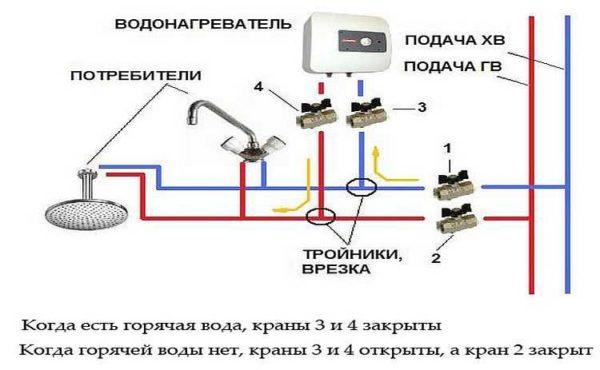
A qualidade da água da torneira deixa muito a desejar e é preferível ligar o esquentador depois do filtro. Se não houver um filtro à entrada do apartamento, é aconselhável instalá-lo imediatamente após o ramal do apartamento ou antes do esquentador.
Numa casa privada, esta unidade funcionará na presença de uma estação de bombagem ou de um sistema auto-montado com um hidroacumulador. É cortado depois de todos os filtros, a partir da saída vem a distribuição aos consumidores.
Ligação da água não pressurizada à água
O termoacumulador elétrico de fluxo não pressurizado (individual) do tipo standard é ligado como um aparelho doméstico normal. Deve existir um ramal de abastecimento de água com uma torneira e uma rosca na extremidade. Com uma mangueira flexível entrançada, o aparelho é ligado ao abastecimento de água.
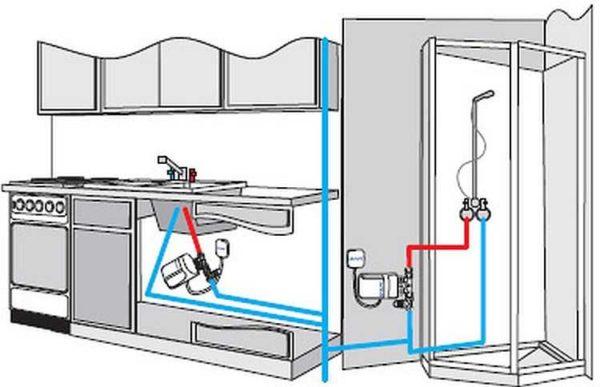
Os bicos da torneira para aquecimento de água são um grupo pequeno. São principalmente aparafusados à rosca na extremidade do bico (pescoço de ganso). Para o fazer, o filtro, que normalmente está aí instalado, é primeiro desaparafusado.
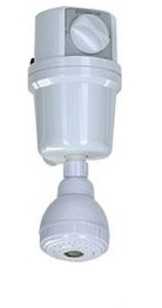
Há algum tempo atrás, existiam bastantes, mas caracterizavam-se por uma baixa eficiência. O bocal em si tem um tamanho sólido e não é possível fixá-lo a uma torneira baixa - fica no caminho. Em Além disso, no mercado existem torneiras com aquecimento elétrico da água, que aquecem melhor a água, têm a capacidade de ajustar a temperatura e são mais práticas no manuseamento. São instaladas no lugar da torneira habitual no lava-loiça ou no lavatório. A única coisa que difere na instalação é a necessidade de ligação eléctrica.
Ligação eléctrica
Qualquer esquentador elétrico é um aparelho potente e requer uma linha de alimentação eléctrica separada. Como exceção, pode ligar à linha que vai para o fogão elétrico - a linha é adequada para os parâmetros. Só neste caso é necessário certificar-se de que o fogão e o aquecedor de fluxo não estão incluídos no trabalho ao mesmo tempo, caso contrário a máquina automática funcionará em sobrecarga.
A ligação do termoacumulador elétrico é normal - a partir da fase do painel, a partir do zero, é enrolada no RCD de dois pinos (certifique-se de que quebra a fase e o zero), depois a fase é enrolada e ligada à máquina automática e só depois é fornecida ao consumidor.
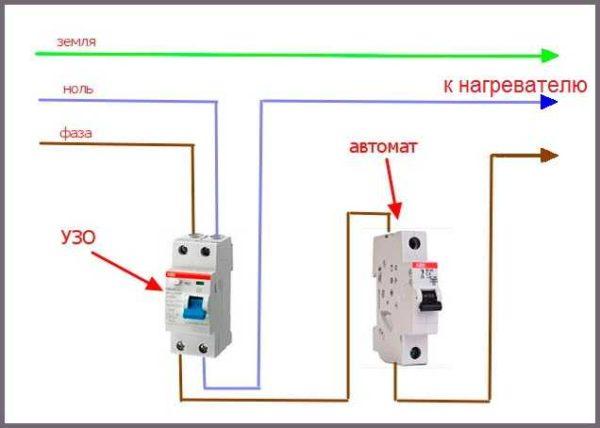
A ligação propriamente dita pode ser efectuada através de uma ficha de três pinos com uma tomada com ligação obrigatória à terra. Também é possível instalar uma placa de contacto ou ligar o cabo diretamente às entradas correspondentes do aquecedor.
Puxar a linha de alimentação eléctrica com fio de cobre (monofilamento):
- até 7 kW secção transversal 3,5 mm;
- de 7 a 12 kW - 4 mm.
A unidade automática é selecionada de acordo com o consumo máximo de corrente (disponível nas especificações técnicas). Selecione o valor nominal superior mais próximo (se selecionar um valor inferior, haverá muitos disparos desnecessários - sempre que atingir a potência máxima). Os RCDs são selecionados com um valor nominal mais elevado, corrente de fuga - 10 mA.
Leia mais sobre a seleção de classificações de disjuntores de proteção aqui.
Tipo de controlo
Ajustar o funcionamento do aquecedor elétrico de água (alterar o grau de aquecimento) pode ser feito com a ajuda de vários reguladores, que estão localizados no painel de controlo. O controlo é hidráulico e eletrónico.
O esquentador elétrico de fluxo com controlo hidráulico aquece a água num determinado número de graus. Está sempre ligado com a potência máxima, mesmo que tenha vários modos de aquecimento diferentes. E mesmo que um dos modos tenha sido definido antes de se desligar, ligar-se-á novamente a partir do máximo.
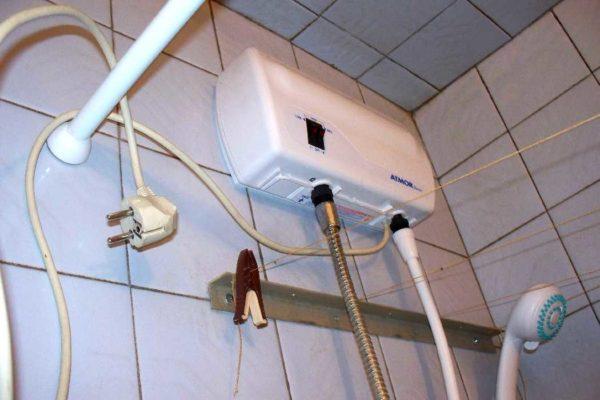
Tem outra caraterística - aquece a água num determinado número de graus. É necessário alterar o grau de aquecimento manualmente, mudando de modo depois de o ligar. E o delta máximo de temperatura é normalmente de 25°C. Ou seja, se na entrada tiver água a +5°C, na saída de um dispositivo deste tipo não pode estar mais quente do que +30°C (com o fluxo total). Isto não significa que a unidade esteja avariada ou que não esteja a funcionar corretamente. Significa que simplesmente não consegue aquecer. É possível corrigir ligeiramente a situação reduzindo a pressão e, assim, conseguir algum aumento da temperatura, mas não se consegue obter água quente em tais condições a partir de uma unidade deste tipo.
As instalações com controlo eletrónico têm normalmente uma grande capacidade e um preço visivelmente mais elevado. Isto deve-se ao facto de terem elementos de aquecimento com regulação de potência em várias fases e de serem mais caros. Além disso, o "recheio" de tal dispositivo é mais complexo - existem vários sensores, além disso, também contém um microprocessador, que processa dados e regula o trabalho dos aquecedores. Se a potência da unidade for selecionada corretamente, ela poderá manter a temperatura definida (geralmente até 40 ° C) com um desvio de um grau.
Seleção de um termoacumulador elétrico de fluxo por capacidade
Qualquer que seja o tipo de esquentador elétrico que escolher, é necessário selecionar corretamente a sua potência. O mais correto, neste caso, é que corresponda às suas expectativas. O mais fácil é concentrar-se no número de torneiras que necessitarão de fornecimento simultâneo de água quente:
Estas capacidades não podem suportar todas as redes eléctricas. Muitas vezes, a potência total atribuída a uma casa ou apartamento é muito menor. Nesse caso, vale a pena considerar a instalação de aquecedores de água de fluxo individual menos potentes ou de um aquecedor de água de armazenamento. Uma excelente opção é uma coluna de gás, mas é para aqueles que têm a possibilidade de se conectar à rede de gás.
Seleção por caudal de água (capacidade)
A escolha de um termoacumulador elétrico pode ser feita em função do caudal necessário. Existem normas de consumo de água quente para diferentes consumidores. Ao somar o caudal necessário para o seu caso, obterá o valor desejado. Portanto, o caudal médio:
Ao selecionar, deve ter tanto o valor da capacidade como o caudal. Neste caso, a água será fornecida a todos os pontos de fluxo que podem ser acionados simultaneamente à temperatura desejada. Caso contrário, terá de se certificar de que apenas uma torneira está aberta de cada vez.
O que o mercado tem para oferecer
A escolha de esquentadores de fluxo elétrico é grande, para dizer o mínimo... É fácil ficar confuso. A que deve prestar atenção, para além da potência e do desempenho? No material de que são feitos o reservatório e o elemento de aquecimento. O reservatório pode ser de cobre, aço inoxidável ou plástico. Esta informação não é fornecida por todos os fabricantes, mas se não for, o mais provável é que o enchimento seja feito de plástico. É, evidentemente, resistente ao calor, mas não tão fiável como os metais.
Preste também atenção à pressão mínima e máxima da água fria, na qual a unidade pode funcionar. Existem modelos caprichosos, para cuja ligação nas nossas redes é necessária a instalação de um redutor.
| Nome | Potência | Dimensões | Capacidade | Número de pontos | Tipo de controlo | Pressão de trabalho | Preço |
|---|---|---|---|---|---|---|---|
| Sistema Thermex 800 | 8 kW | 270*95*170 mm | 6 l/min | 1-3 | hidráulico | 0,5-6 bar | 73$ |
| Electrolux Smartfix 2.0 TS (6,5 kW) | 6,5 kW | 270*135*100 mm | 3,7 l/min | 1 | hidráulico | 0,7-6 bar | 45$ |
| AEG RMC 75 | 7,5 kW | 200*106*360 mm | 1-3 | eletrónica | 0,5-10 BAR | 230$ | |
| Stiebel Eltron DHM 3 | 3 kW | 190*82*143 mm | 3,7 l/min | 1-3 | hidráulico | 6 Barras | 290$ |
| Evan B1 - 9,45 | 9,45 kW | 260*190*705 mm | 3,83 l/min | 1 | mecânico | 0,49-5,88 bar | 240$ |
| Electrolux NPX 8 Flow Active | 8,8 kW | 226*88*370 mm | 4,2 l/min | 1-3 | eletrónica | 0,7-6 bar | 220$ |
Separadamente, vale a pena falar de torneiras com aquecimento elétrico de água. Eles também são chamados de aquecedor de água de torneira. Eles apareceram não há muito tempo, mas estão rapidamente ganhando popularidade, pois são convenientes de usar, simplesmente conectados.
| Nome | Tipo de controlo | Gama de aquecimento | Pressão de trabalho | Tamanho da ligação | Potência / tensão | Material da caixa | Preço |
|---|---|---|---|---|---|---|---|
| ATLANTA ATH-983 | automático | 30-85°C | 0,05 a 0,5MPa | 1/2″ | 3 kW / 220 V | cerâmica | 40-45$ |
| Aquatherm KA-002 | mecânico | até +60°C | 0,04 a 0,7 MPa | 1/2″ | 3 kW / 220 V | plástico composto | 80$ |
| Aquatherm KA-26 | mecânico | até +60°C | 0,04 a 0,7 MPa | 1/2″ | 3 kW / 220 V | plástico composto | 95-100$ |
| Delimano | automático | até +60°C | 0,04 - 0,6 MPa | 1/2″ | 3 kW/220-240 V | plástico, metal | 45$ |
| L.I.Z. (Delimano) | hidráulico | até +60°C | 0,04-0,6 MPa | 1/2″ | 3 kW/220-240 V | plástico ABS resistente ao calor | 50$ |

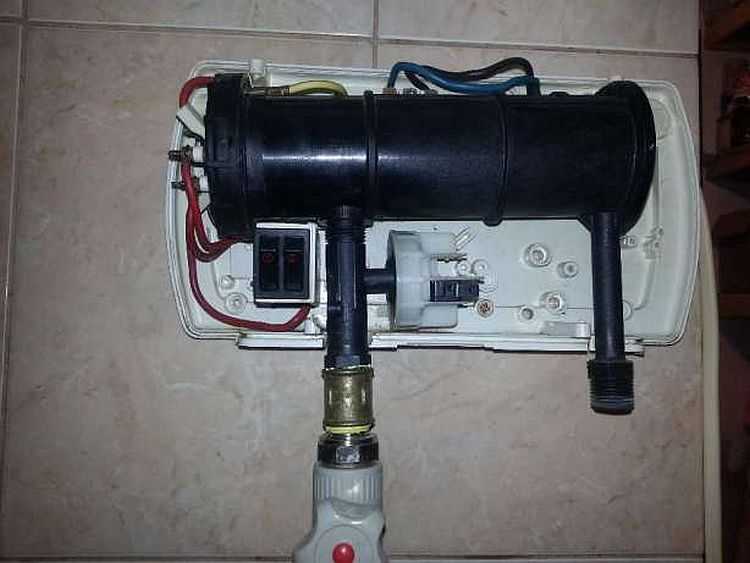
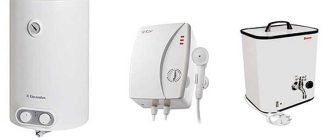
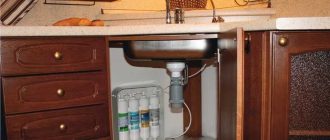
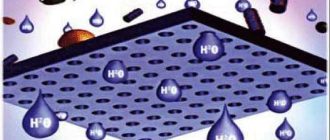
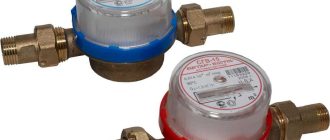
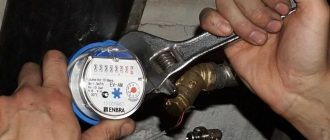
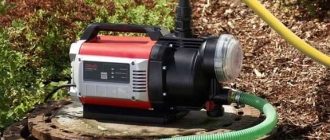
A escolha de um esquentador elétrico de fluxo pode ser complicada! Procure um com uma boa classificação energética e potência suficiente para as suas necessidades. Lembro-me de ter escolhido um que aquecia a água muito rapidamente, perfeito para as minhas manhãs atarefadas. Certifique-se de que verifica as avaliações e a garantia também!